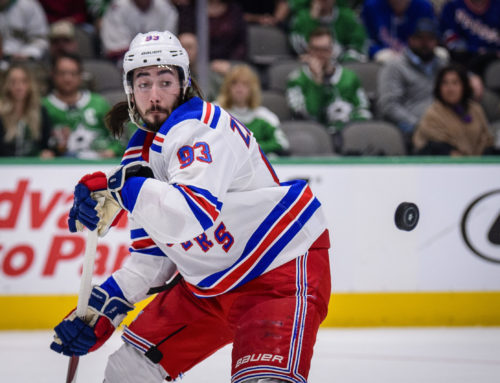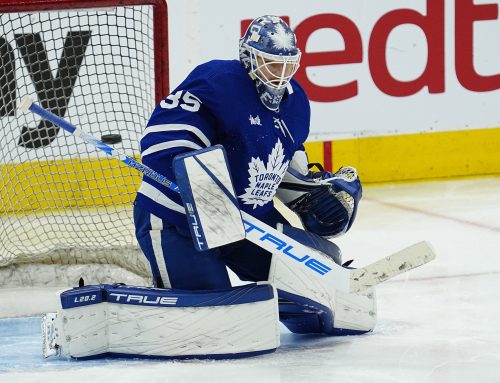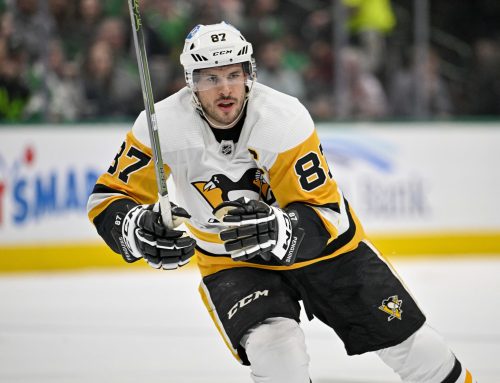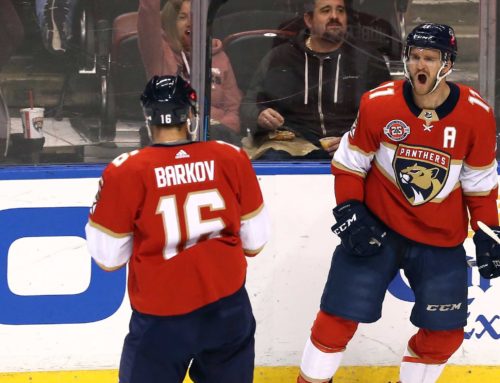Eastern Edge: Increases and decreases in both ice time and production
Brennan Des
2020-04-28
In this week's Eastern Edge, we'll take a look at how ice time affected offensive production this year. I'll highlight players that performed well when trusted with more ice time than last season, as well as players whose production suffered while seeing a reduced role.
In the tables below, I've listed players that saw a significant change in both ice time and point production between this season (2019-2020) and last season (2018-2019). Players were divided into two groups, the first of which includes players that saw more ice time and put up more points, while the second consists of players that saw less ice time and put up fewer points. The 'Δ Ice Time' column (minutes: seconds) shows how much a player's average ice time changed from last season. The 'Δ Point Pace' column represents the difference in a player's 82-game point pace between this year and last year. For example, Andrei Svechnikov put up 61 points in 68 games this season, which translates to 74 points over 82 games. Last season, he managed 37 points through 82 games. Therefore, his point pace has increased by 37 points – from 37 to 74.
The final column of the table (Δ Point Pace/Δ Ice Time) shows how much a player's offensive production changed relative to his ice time. As shown in Table 1, a large positive value indicates that a player made the most of his increased role, while smaller positive values indicate that a player wasn't as productive. For example, Svechnkivov's point pace increased by 37 despite a modest two-minute increase in ice time. So, Svechnikov's improvement would be considered more impressive than that of Connor Brown – whose production increased by only 21 points despite a massive six-minute increase in ice time.
In table 2, we see negative values in the 'Δ Point Pace/Δ Ice Time' column. In this case, more negative values are more concerning, as they indicate that a player's production decreased dramatically. For example, while both Sean Couturier and Jeff Skinner saw their ice time drop by approximately two minutes, Skinner's offensive output suffered a lot more – which is why he has a more negative value in the 'Δ Point Pace/Δ Ice Time' column.
Hopefully these explanations make sense, but I found myself getting confused while re-reading them. So, if you have any questions, please feel free to ask in the comments below. Without further ado, here are my findings:
Table 1: Increased Ice Time, Increased Production
| Player | Δ Ice Time | Δ Point Pace | Δ Point Pace/Δ Ice Time |
| Andrei Svechnikov | 2:05 | 37 | 17.76 |
| Jakub Vrana | 0:51 | 15 | 17.65 |
| Travis Konecny | 1:32 | 27 | 17.61 |
| Jordan Eberle | 1:17 | 18 | 14.03 |
| Bryan Rust | 3:52 | 43 | 11.12 |
| William Nylander | 2:42 | 30 | 11.11 |
| Jake Guentzel | 1:17 | 14 | 10.91 |
| Ryan Strome | 4:01 | 34 | 8.46 |
| Anthony Beauvillier | 2:37 | 19 | 7.26 |
| Zach Hyman | 1:49 | 12 | 6.61 |
| Alex Killorn | 3:04 | 19 | 6.20 |
| Mathew Barzal | 2:08 | 10 | 4.69 |
| Jack Eichel | 1:40 | 7 | 4.20 |
| Oliver Bjorkstrand | 5:36 | 22 | 3.93 |
| Anthony Cirelli | 3:37 | 14 | 3.87 |
| Anthony Duclair | 3:34 | 13 | 3.64 |
| Pavel Buchnevich | 1:46 | 6 | 3.40 |
| Connor Brown | 6:19 | 21 | 3.32 |
| Auston Matthews | 2:25 | 6 | 2.48 |
Quick Notes
Andrei Svechnikov clearly isn't familiar with the sophomore slump. The 20-year-old forward improved on a solid rookie campaign and earned a spot on Carolina's top line, alongside the incredible talent of Sebastian Aho and Teuvo Teravainen.
Jakub Vrana put up a 62-point pace this year, despite averaging less than 15 minutes of action per game. Hopefully his role will grow even more next year, which should boost his offensive output and fantasy value.
Over the past few seasons, Bryan Rust had established himself as a 40-point-player. He took on a bigger role this year as the Penguins suffered a number of significant injuries – ultimately shattering our expectations with an 83-point pace. I'm curious to see what his ice time will look like going forward, assuming the roster is healthy, and Jake Guentzel is back in the lineup.
Ryan Strome had been averaging around 15 minutes of ice time over the past few years and consistently posted a 35-point pace. His ice time jumped up to 19 minutes this season and he made the most of the new opportunity, registering a 69-point pace. Nice!
Table 2: Decreased Ice Time, Decreased Production
| Player | Δ Ice Time | Δ Point Pace | Δ Point Pace/Δ Ice Time |
| Nikita Kucherov | -1:06 | -25 | -22.73 |
| Jeff Skinner | -2:02 | -31 | -15.25 |
| Nino Niederreiter | -1:25 | -18 | -12.71 |
| Evgenii Dadonov | -1:16 | -14 | -11.05 |
| Evgeny Kuznetsov | -0:56 | -10 | -10.71 |
| Claude Giroux | -2:28 | -22 | -8.92 |
| Aleksander Barkov | -2:20 | -19 | -8.14 |
| Yanni Gourde | -1:46 | -14 | -7.92 |
| James van Riemsdyk | -1:42 | -10 | -5.88 |
| Sean Couturier | -2:18 | -8 | -3.48 |
Quick Notes
I personally think that Skinner's struggles this year can be explained by two things. One – he lost his role as the trigger-man on Buffalo's power-play to Victor Olofsson. Two – he lost his role on the top line beside Jack Eichel. The Sabres don't exactly have a wealth of talent beyond the top line, so playing reduced minutes with lesser talent was ultimately Skinner's recipe for disaster. Check out a more in-depth look on Skinner in Sunday's Geek of the Week column.
When Nino Niederreiter arrived in Carolina last year, he put up 30 points in his first 36 games as a member of the Hurricanes, skating on the top line beside Sebastian Aho and Justin Williams. While Niederreiter began the 2019-2020 campaign on the team's top line, his struggles resulted in his relegation to a depth role – as Svechnikov took his spot on the top line. I can't see Neiderrereiter putting up 50 or more points while skating less than 15 minutes a night outside of the top-six.
Sean Couturier saw a significant drop in ice time this season compared to last season, as he went from averaging 22 minutes a night to 20 minutes a night. I think it's pretty impressive that he was still able to register a 70-point pace this year, despite a significantly reduced role. While the Flyers have an abundance of talent at the center position (assuming Nolan Patrick is healthy next year), I wouldn't expect Couturier's ice time to continue declining next season. He's proven to be an excellent two-way player and I don't see his ice time dropping much lower than 20 minutes a night.





 MTL
MTL T.B
T.B TOR
TOR COL
COL CAR
CAR VAN
VAN EDM
EDM VGK
VGK WPG
WPG
